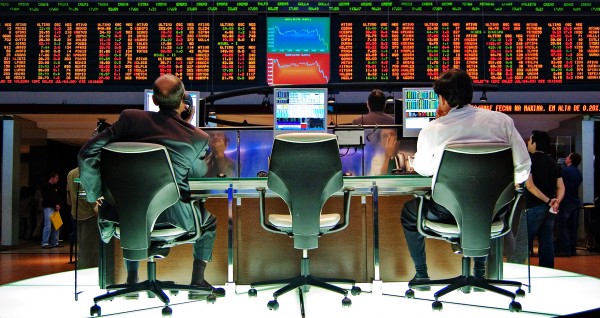 Thirty years ago, on Monday 19 October 1987, stock markets around the world tumbled. The day has been dubbed ‘Black Monday’. Wall Street fell by 22% – its biggest ever one-day fall. The FTSE 100 fell by 10.8% and by a further 12.2% the next day.
Thirty years ago, on Monday 19 October 1987, stock markets around the world tumbled. The day has been dubbed ‘Black Monday’. Wall Street fell by 22% – its biggest ever one-day fall. The FTSE 100 fell by 10.8% and by a further 12.2% the next day.
The crash caught most people totally by surprise and has never been fully explained. The most likely cause was an excessive rise in the previous three years, when share prices more than doubled. This was combined with the lack of ‘circuit breakers’, which today would prevent excessive selling, and a ‘herd’ effect as people rushed to get out of shares before they fell any further, creating a massive wave of destabilising speculation.
Within a few weeks, share prices started rising again and within three years shares were once again trading at levels before Black Monday.
 Looking back to the events of 30 years ago, the question many fund managers and others are asking is whether global stock markets are in for another dramatic downward correction. But there is no consensus of opinion about the answer.
Looking back to the events of 30 years ago, the question many fund managers and others are asking is whether global stock markets are in for another dramatic downward correction. But there is no consensus of opinion about the answer.
Those predicting a downward correction – possibly dramatic – point to the fact that stock markets, apart from a dip in mid-2016, have experienced several years of growth, with yields now similar to those in 1987. Price/earnings ratios, at around 18, are high relative to historical averages.
What is more, the huge increases in money supply from quantitative easing, which helped to inflate share prices, are coming to an end. The USA ceased its programme three years ago and the ECB is considering winding down its programme.
Also, once a downward correction starts, destabilising speculation is likely to kick in, with people selling shares before they go any lower. This could be significantly aggravated by the rise of electronic markets with computerised high-frequency trading.
However, people predicting that there will be little or no downward correction, and even a continuing bull market, point to differences between now and 1987. First, the alternatives to shares look much less attractive than then. Bond yields and interest rates in banks (at close to zero), unlike in 1987, are much lower than the dividend yields on shares (at around 4%). Second, there are circuit breakers in stock markets that suspend dealing in cases of large falls.
But even if there is a downward correction, it will probably be relatively short-lived, with the upward trend in share prices continuing over the long term. If you look at the chart above, you can see this trend, but you can also see periods of falling share prices in the late 1990s/early 2000s and in the financial crisis of 2008–9. Looking back to 1987, it seems like a mere blip from the perspective of 30 years – but it certainly didn’t at the time.
Articles
Three decades since Black Monday – are markets on the verge of another tumble? The Telegraph, Lucy Burton (19/10/17)
Black Monday: 30 years on from the 1987 crash Citywire, Michelle McGagh (19/10/17)
30 Years Ago: Lessons From the 1987 Market Crash U.S.News, Debbie Carlson (12/10/17)
Black Monday: Can a 1987-style stock market crash happen again? USA Today, Adam Shell (19/10/17)
Black Monday anniversary: How the 2017 stock market compares with 1987 MarketWatch, William Watts (19/10/17)
30 years after Black Monday, could stock market crash again? MarketWatch, William Watts (19/10/17)
 The Crash of ’87, From the Wall Street Players Who Lived It Bloomberg, Richard Dewey (19/10/17)
The Crash of ’87, From the Wall Street Players Who Lived It Bloomberg, Richard Dewey (19/10/17)
Questions
- Explain what are meant by ‘bull markets’ and ‘bear markets’.
- Share prices are determined by demand and supply. Identify the various demand- and supply-side factors that have led to the current long bull-market run.
- What caused the Black Monday crash in 1987?
- For what reasons may global stock markets soon (a) experience, (b) not experience a downward correction?
- Distinguish between stabilising speculation and destabilising speculation on stock markets.
- What determines when a downward correction on stock markets bottoms out?
- Explain how stock market circuit breakers work. Can they prevent a fundamental correction?
- Does the rise in computerised trading make a stock market crash more or less likely?
 Both the financial and goods markets are heavily influenced by sentiment. And such sentiment tends to be self-reinforcing. If consumers and investors are pessimistic, they will not spend and not invest. The economy declines and this further worsens sentiment and further discourages consumption and investment. Banks become less willing to lend and stock markets fall. The falling stock markets discourage people from buying shares and so share prices fall further. The despondency becomes irrational and greatly exaggerates economic fundamentals.
Both the financial and goods markets are heavily influenced by sentiment. And such sentiment tends to be self-reinforcing. If consumers and investors are pessimistic, they will not spend and not invest. The economy declines and this further worsens sentiment and further discourages consumption and investment. Banks become less willing to lend and stock markets fall. The falling stock markets discourage people from buying shares and so share prices fall further. The despondency becomes irrational and greatly exaggerates economic fundamentals.
This same irrationality applies in a boom. Here it becomes irrational exuberance. A boom encourages confidence and stimulates consumer spending and investment. This further stimulates the boom via the multiplier and accelerator and further inspires confidence. Banks are more willing to lend, which further feeds the expansion. Stock markets soar and destabilising speculation further pushes up share prices. There is a stock market bubble.
 But bubbles burst. The question is whether the current global stock market boom, with share prices reaching record levels, represents a bubble. One indicator is the price/earnings (PE) ratio of shares. This is the ratio of share prices to earnings per share. Currently the ratio for the US index, S&P 500, is just over 26. This compares with a mean over the past 147 years of 15.64. The current ratio is the third highest after the peaks of the early 2000s and 2008/9.
But bubbles burst. The question is whether the current global stock market boom, with share prices reaching record levels, represents a bubble. One indicator is the price/earnings (PE) ratio of shares. This is the ratio of share prices to earnings per share. Currently the ratio for the US index, S&P 500, is just over 26. This compares with a mean over the past 147 years of 15.64. The current ratio is the third highest after the peaks of the early 2000s and 2008/9.
An alternative measure of the PE ratio is the Shiller PE ratio (see also). This is named after Robert Shiller, who wrote the book Irrational Exuberance. Unlike conventional PE ratios, which only look at average earnings over the past four quarters, the Shiller PE ratio uses average earnings over the past 10 years. “Because this factors in earnings from the previous ten years, it is less prone to wild swings in any one year.”
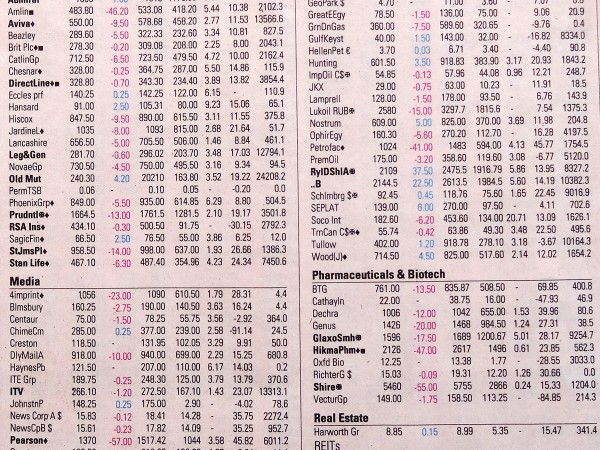 The current level of the Shiller PE ratio is 29.14, the third highest on record, this time after the period running up to the Wall Street crash of 1929 and the dot-com bubble of the late 1990s. The mean Shiller PE ratio over the past 147 years is 16.72.
The current level of the Shiller PE ratio is 29.14, the third highest on record, this time after the period running up to the Wall Street crash of 1929 and the dot-com bubble of the late 1990s. The mean Shiller PE ratio over the past 147 years is 16.72.
So are we in a period of irrational exuberance? And are stock markets experiencing a bubble that sooner or later will burst? The following articles explore these questions.
Articles
2 Clear Instances of Irrational Exuberance Seeking Alpha, Jeffrey Himelson (12/2/17)
Promised land of Trumpflation-inspired global stimulus has been slow off the mark South China Morning Post, David Brown (20/2/17)
A stock market crash is a way off, but this boom will turn to bust The Guardian, Larry Elliott (16/2/17)
The “boring” bubble is close to bursting – the Unilever bid proves it MoneyWeek, John Stepek (20/2/17)
Questions
- Find out what is meant by Minksy’s ‘financial instability hypothesis’ and a ‘Minsky moment’. How might they explain irrational exuberance and the sudden turning point from a boom to a bust?
- Is it really irrational to buy shares with a very high PE ratio if everyone else is doing so?
- Why are people currently exuberant?
- What might cause the current exuberance to end?
- How does irrational exuberance affect the size of the multiplier?
- How might the behaviour of banks and other financial institutions contribute towards a boom fuelled by irrational exuberance?
- Compare the usefulness of a standard PE ratio with the Shiller PE ratio.
- Other than high PE ratios, what else might suggest that stock markets are overvalued?
- Why might a company’s PE ratio differ from its price/dividends ratio (see)? Which is a better measure of whether or not a share is overvalued?
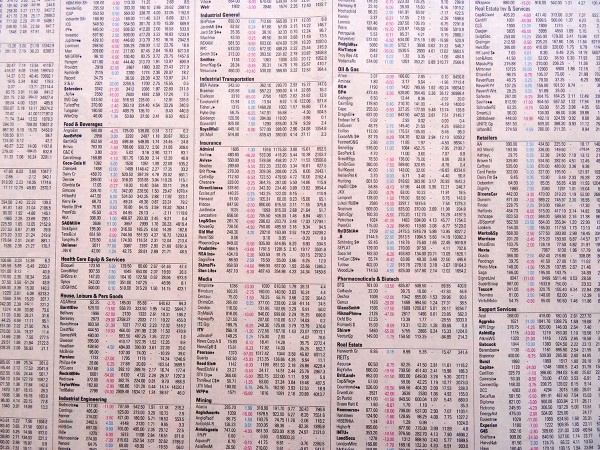 Over 2015 quarter 3, stock markets around the world have seen their biggest falls for four years. As the BBC article states: ‘the numbers for the major markets from July to September make for sobering reading’.
Over 2015 quarter 3, stock markets around the world have seen their biggest falls for four years. As the BBC article states: ‘the numbers for the major markets from July to September make for sobering reading’.
• US Dow Jones: –7.9%
• UK FTSE 100: –7.04%
• Germany Dax: –11.74%
• Japan Nikkei: –14.47%
• Shanghai Composite: –24.69%
So can these falls be fully explained by the underlying economic situation or is there an element of over-correction, driven by pessimism? And, if so, will markets bounce back somewhat? Indeed, from 30 September to 2 October, markets did experience a rally. For example, the FTSE 100 rose from a low of 5877 on 29 September to close at 6130 on 3 October (a rise of 4.3%). But is this what is known as a ‘dead cat bounce’, which will see markets fall back again as pessimism once more takes hold?
As far as the global economic scenario is concerned, things have definitely darkened in the past few months. As Christine Lagarde, Managing Director of the IMF, said in an address in Washington ahead of the release of the IMF’s 6-monthly, World Economic Outlook:
I am concerned about the state of global affairs. The refugee influx into Europe is the latest symptom of sharp political and economic tensions 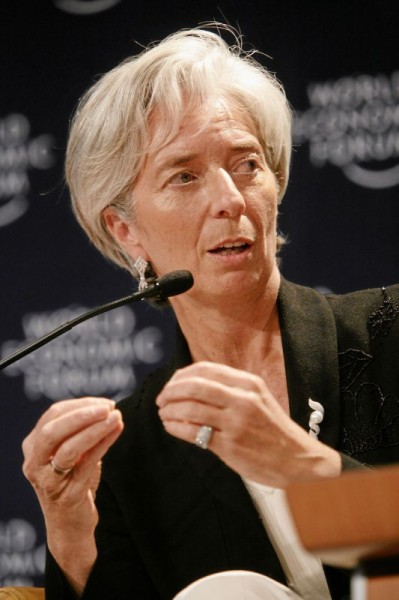 in North Africa and the Middle East. While this refugee crisis captures media attention in the advanced economies, it is by no means an isolated event. Conflicts are raging in many other parts of the world, too, and there are close to 60 million displaced people worldwide.
in North Africa and the Middle East. While this refugee crisis captures media attention in the advanced economies, it is by no means an isolated event. Conflicts are raging in many other parts of the world, too, and there are close to 60 million displaced people worldwide.
Let us also not forget that the year 2015 is on course to be the hottest year on record, with an extremely strong El Niño that has spawned weather-related calamities in the Pacific.
On the economic front, there is also reason to be concerned. The prospect of rising interest rates in the United States and China’s slowdown are contributing to uncertainty and higher market volatility. There has been a sharp deceleration in the growth of global trade. And the rapid drop in commodity prices is posing problems for resource-based economies.
Words such as these are bound to fuel an atmosphere of pessimism. Emerging economies are expected to see slowing economic growth for the fifth year in succession. 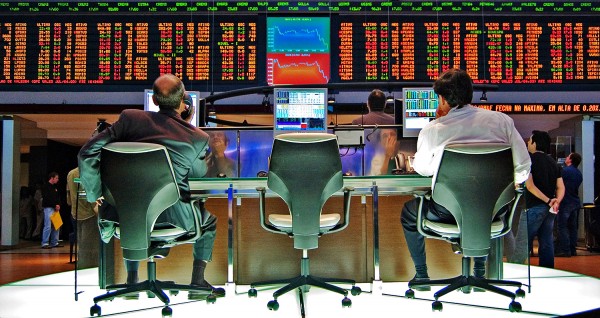 And financial stability is still not yet assured despite efforts to repair balance sheets following the financial crash of 2008/9.
And financial stability is still not yet assured despite efforts to repair balance sheets following the financial crash of 2008/9.
But as far as stock markets are concerned, the ECB is in the process of a massive quantitative easing programme, which will boost asset prices, and Japan looks as if it too will embark on a further round of QE. Interest rates remain very low, and, as we discussed in the blog Down down deeper and down, or a new Status Quo?, some central banks now have negative rates of interest. This makes shares relatively attractive for savers, so long as it is believed that they will rise over the medium term.
 Then there is the question of speculation. The falls were partly due to people anticipating that share prices would fall. But has this led to overshooting, with prices set to rise again? Or, will pessimism set in once more as people become even gloomier about the world economy? If only I had a crystal ball!
Then there is the question of speculation. The falls were partly due to people anticipating that share prices would fall. But has this led to overshooting, with prices set to rise again? Or, will pessimism set in once more as people become even gloomier about the world economy? If only I had a crystal ball!
Articles
Markets see their worst quarter in four years BBC News (1/10/15)
Weak Jobs Data Can’t Keep U.S. Stocks Down Wall Street Journal, Corrie Driebusch (2/10/15)
What the 3rd Quarter Tells Us About The Stock Market In October EFT Trends, Gary Gordon (2/10/15)
The bull market ahead: Why shares should make 6.7pc a year until 2025 The Telegraph, Kyle Caldwell (5/9/15)
Is the FTSE 100’s six year run at an end? The bull and bear points The Telegraph, Kyle Caldwell (24/8/15)
Webcasts
 The stock market bull may not be dead yet CNNMoney (29/9/15)
The stock market bull may not be dead yet CNNMoney (29/9/15)
 IMF’s Lagarde: More volatility likely for emerging markets CNBC, Everett Rosenfeld (30/9/15)
IMF’s Lagarde: More volatility likely for emerging markets CNBC, Everett Rosenfeld (30/9/15)
 What’s next for stocks after worst quarter in four year CNBC, Patti Domm (30/9/15)
What’s next for stocks after worst quarter in four year CNBC, Patti Domm (30/9/15)
 Global markets to log worst quarter since 2011 CNBC, Nyshka Chandran (30/9/15)
Global markets to log worst quarter since 2011 CNBC, Nyshka Chandran (30/9/15)
Speech
Managing the Transition to a Healthier Global Economy IMF, Christine Lagarde (30/9/15)
Questions
- Distinguish between stabilising and destabilising speculation. Is it typical over a period of time that you will get both? Explain.
- What is meant by a ‘dead cat bounce’? How would you set about identifying whether a given rally was such a phenomenon?
- Examine the relationship between the state (and anticipated state) of the global economy and share prices.
- What is meant by (a) the dividend yield on a share; (b) the price/earnings ratio of a share? Investigate what has been happening to dividend yields and price/earnings ratios over the past few months. What is the relationship between dividend yields and share prices?
- Distinguish between bull and bear markets.
- What factors are likely to drive share prices (a) higher; (b) lower?
- Is now the time for investors to buy shares?
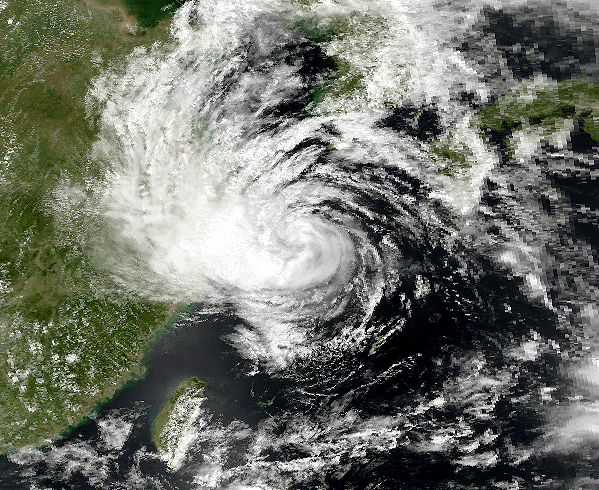 The mood has changed in international markets. Investors are becoming more pessimistic about recovery in the world economy and of the likely direction of share prices. Concern has centred on the Chinese economy. Forecasts are for slower Chinese growth (but still around 5 to 7 per cent) and worries centre on the impact of this on the demand for other countries’ exports.
The mood has changed in international markets. Investors are becoming more pessimistic about recovery in the world economy and of the likely direction of share prices. Concern has centred on the Chinese economy. Forecasts are for slower Chinese growth (but still around 5 to 7 per cent) and worries centre on the impact of this on the demand for other countries’ exports.
The Chinese stock market has been undergoing turmoil over the past few weeks, and this has added to jitters on other stock markets around the world. Between the 5th and 24th of August, the FTSE 100 fell by 12.6%, from 6752 to 5898; the German DAX fell by 17.1% from 11,636 to 9648 and the US DOW Jones by 10.7% from 17,546 to 15,666. Although markets have recovered somewhat since, they are very volatile and well below their peaks earlier this year.
But are investors right to be worried? Will a ‘contagion’ spread from China to the rest of the world, and especially to its major suppliers of raw materials, such as Australia, and manufactured exports, such as the USA and Germany? Will other south-east Asian countries continue to slow? Will worries lead to continued falls in stock markets as pessimism becomes more entrenched? Will this then impact on the real economy and lead then to even further falls in share prices and further falls in aggregate demand?

Or will the mood of pessimism evaporate as the Chinese economy continues to grow, albeit at a slightly slower rate? Indeed, will the Chinese authorities introduce further stimulus measures (see the News items What a devalued yuan means to the rest of the world and The Shanghai Stock Exchange: a burst bubble?), such as significant quantitative easing (QE)? Has the current slowing in China been caused, at least in part, by a lack of expansion of the monetary base – an issue that the Chinese central bank may well address?
Will other central banks, such as the Fed and the Bank of England, delay interest rate rises? Will the huge QE programme by the ECB, which is scheduled to continue at €60 billion until at least September 2016, give a significant boost to recovery in Europe and beyond?
The following articles explore these questions.
Articles
The Guardian view on China’s meltdown: the end of a flawed globalisation The Guardian, Editorial (1/9/15)
Central banks can do nothing more to insulate us from the Asian winter The Guardian, Business leader (6/9/15)
Where are Asia’s economies heading BBC News, Karishma Vaswani (4/9/15)
How China’s cash injections add up to quantitative squeezing The Economist (7/9/14)
Nouriel Roubini dismisses China scare as false alarm, stuns with optimism The Telegraph, Ambrose Evans-Pritchard (4/9/15)
 Markets Are Too Pessimistic About Chinese Growth Bloomberg, Nouriel Roubini (4/9/15)
Markets Are Too Pessimistic About Chinese Growth Bloomberg, Nouriel Roubini (4/9/15)
Data
World Economic Outlook databases IMF: see, for example, data on China, including GDP growth forecasts.
Market Data Yahoo: see, for example, FTSE 100 data.
Questions
- How do open-market operations work? Why may QE be described as an extreme form of open-market operations?
- Examine whether or not the Chinese authorities have been engaging in monetary expansion or monetary tightening.
- Is an expansion of the monetary base necessary for there to be a growth in broad money?
- Why might the process of globalisation over the past 20 or so years be described a ‘flawed’?
- Why have Chinese stock markets been so volatile in recent weeks? How seriously should investors elsewhere take the large falls in share prices on the Chinese markets?
- Would it be fair to describe the Chinese economy as ‘unstable, unbalanced, uncoordinated and unsustainable’?
- What is the outlook over the next couple of years for Asian economies? Explain.
- For what reasons might stock markets have overshot in a downward direction?
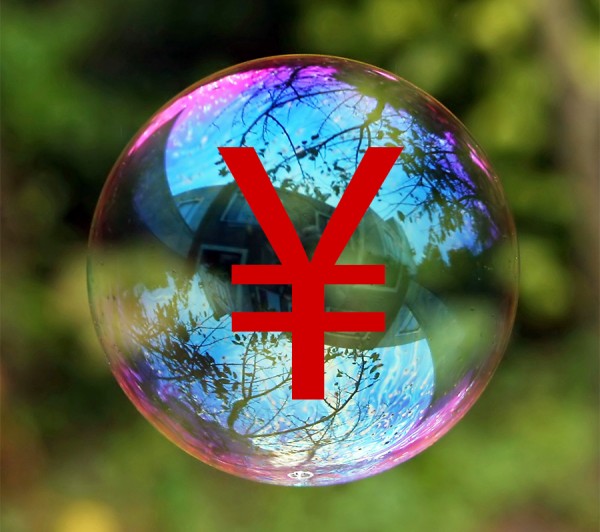 Many Chinese people have taken to investing on the Chinese stock market, seeing it as a way of making a lot of money quickly. From October 2014 to June this year the market soared, rising by 126% from 2290 to 5166.
Many Chinese people have taken to investing on the Chinese stock market, seeing it as a way of making a lot of money quickly. From October 2014 to June this year the market soared, rising by 126% from 2290 to 5166.
More and more people used their savings to buy stocks and China now has over 90 million individual investors. And it was not just savings that were invested. Increasingly people have been borrowing money to invest, seeing it as an easy way of making money. Unlike stock markets in developed countries, where the majority of shares are held by financial organisations, such as pension funds, holdings by individuals account for about 80% of stocks on the Chinese market.
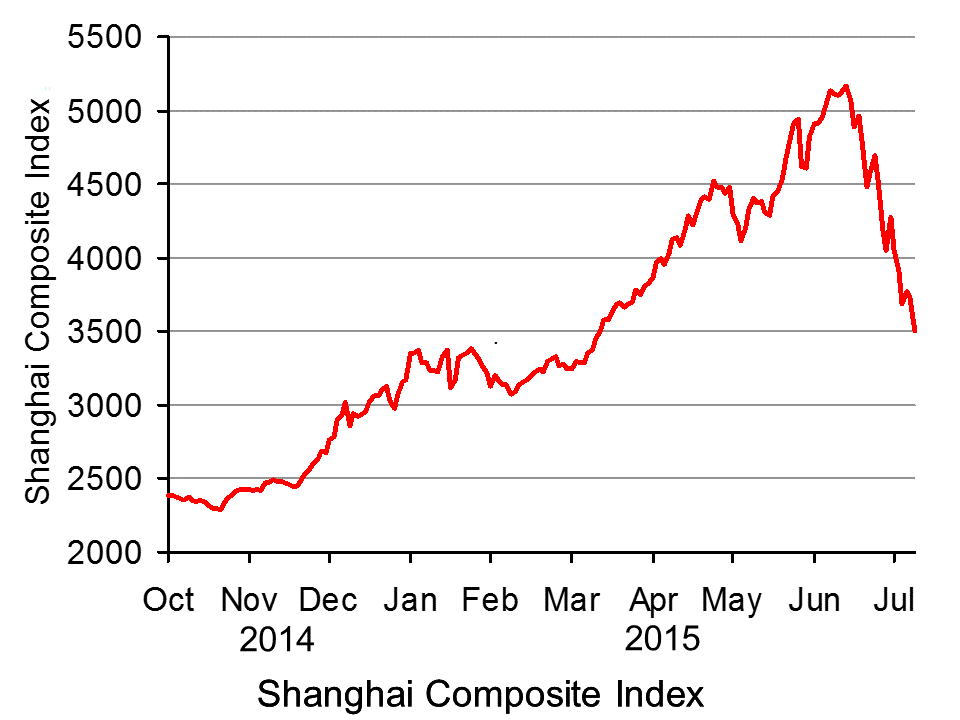 But since mid-June, share prices have plummeted by 32% (see chart). People have thus seen a huge fall in the value of their savings, while many others have found their shareholdings worth less than their debts. The fall, like the rise that preceded it, has been driven by speculation, fuelled by first optimism and then pessimism.
But since mid-June, share prices have plummeted by 32% (see chart). People have thus seen a huge fall in the value of their savings, while many others have found their shareholdings worth less than their debts. The fall, like the rise that preceded it, has been driven by speculation, fuelled by first optimism and then pessimism.
The Chinese government is worried that the fall might dampen investment and economic growth. It has thus has been supplying liquidity to various institutions to buy shares, but this has had little effect and is dismissed by many as meddling. What is more it could expose companies which take advantage of the liquidity to greater risk.
So serious has been the rout, that over 50% of listed companies have halted trading on the mainland Chinese stock exchanges.
So just why has there been this bubble and why has it burst? What implications will it have for (a) China and (b) the rest of the world? The following articles explore the issues.

China’s stock market fall hits small investors BBC News Magazine, John Sudworth (7/7/15)
 China Stocks Plunge as State Support Fails to Revive Confidence Bloomberg (8/7/15)
China Stocks Plunge as State Support Fails to Revive Confidence Bloomberg (8/7/15)
Chinese stocks are crashing Business Insider UK, Myles Udland, David Scutt (8/7/15)
Shanghai stocks plunge, over 1,200 Chinese companies halt trading Economic Times of India (8/7/15)
Everyone freaking out about China’s stock-market crash is missing one thing Business Insider UK, Elena Holodny (7/7/15)
China’s stock market has lost nearly a third of its value in a month Vox, Timothy B. Lee (8/7/15)
Chinese leaders may be undermined as investors suffer stock market slide The Guardian, Emma Graham-Harrison (8/7/15)
Opinion: China’s stock-market crash is just beginning MarketWatch, Howard Gold (8/7/15)
What does China’s stock market crash tell us? BBC News (22/7/15)
Questions
- What is meant by a ‘bubble’? Has the recent performance of the Shanghai Stock Market been an example of a bubble?
- Is the current fall in share prices in China an example of overshooting? Explain how you would decide.
- Distinguish between stabilising and destabilising speculation. Why does destabilising speculation not go on for ever?
- What is meant by the ‘stock market wealth effect’? How is the fall in the Chinese stock market likely to affect consumption and investment in China? How does the proportion of assets held in the form of shares affect the magnitude of the effect?
- What are the likely implications of the fall in the Chinese stock market for the rest of the world?
- Why has the Hong Kong stock market not behaved in the same way as the Shanghai market?
- What have the Chinese authorities been doing to arrest the fall in share prices? How likely are they to succeed?
 Thirty years ago, on Monday 19 October 1987, stock markets around the world tumbled. The day has been dubbed ‘Black Monday’. Wall Street fell by 22% – its biggest ever one-day fall. The FTSE 100 fell by 10.8% and by a further 12.2% the next day.
Thirty years ago, on Monday 19 October 1987, stock markets around the world tumbled. The day has been dubbed ‘Black Monday’. Wall Street fell by 22% – its biggest ever one-day fall. The FTSE 100 fell by 10.8% and by a further 12.2% the next day. Looking back to the events of 30 years ago, the question many fund managers and others are asking is whether global stock markets are in for another dramatic downward correction. But there is no consensus of opinion about the answer.
Looking back to the events of 30 years ago, the question many fund managers and others are asking is whether global stock markets are in for another dramatic downward correction. But there is no consensus of opinion about the answer. The Crash of ’87, From the Wall Street Players Who Lived It Bloomberg, Richard Dewey (19/10/17)
The Crash of ’87, From the Wall Street Players Who Lived It Bloomberg, Richard Dewey (19/10/17)








